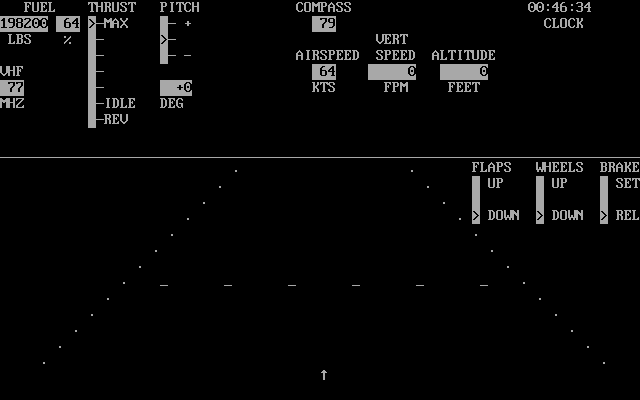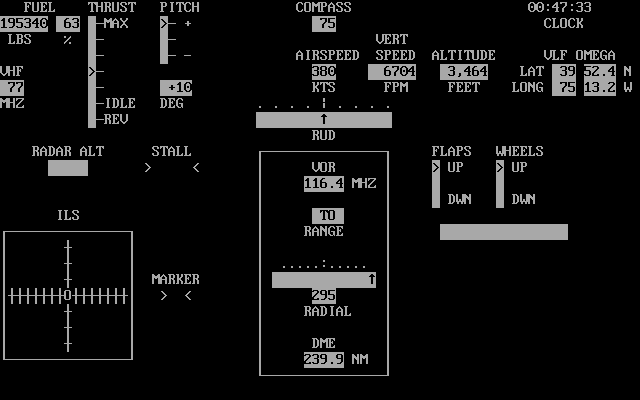Retro Replay Review
Gameplay
Jetset places you directly in the cockpit of a Boeing 747 using only text-based panels and keyboard commands. From the moment you load the simulation, every action—throttle control, flap adjustments, radio communications—is handled through succinct prompts and keyed inputs. This minimalist control scheme may feel daunting at first, but it quickly becomes second nature as you learn to navigate the airplane’s extensive checklist and flight procedures.
(HEY YOU!! We hope you enjoy! We try not to run ads. So basically, this is a very expensive hobby running this site. Please consider joining us for updates, forums, and more. Network w/ us to make some cash or friends while retro gaming, and you can win some free retro games for posting. Okay, carry on 👍)
The core of Jetset’s gameplay lies in its realistic physics engine, which meticulously models factors such as airspeed, altitude, wind drift and fuel consumption. Pilots must carefully manage climb rates, descent profiles, and approach speeds. One minor miscalculation—too steep an ascent or an overly rapid descent—and you’ll feel the consequences in the form of a rough ride or an aborted landing. Despite the lack of graphical flourishes, the simulator captures the tension and precision of real-world aviation.
Takeoffs and landings highlight Jetset’s only graphical moment: an ASCII runway outline that appears when you’re lining up for departure or touchdown. Even this simple visual cue heightens the stakes, as you gauge your angle against a string of characters representing runway lights and markers. Every phase between these moments unfolds entirely through instrument readings, making the gameplay a cerebral challenge in situational awareness and procedure mastery.
Graphics
In 1982, BYTE magazine introduced Jetset’s code as a showcase for text-mode capabilities on early PCs. Rather than pixel-based scenery, you’re greeted with neatly organized tables of data: altimeter readings, heading degrees, vertical speed indicators, and more. The visual restraint encourages you to focus not on dazzling visuals but on interpreting and acting upon numerical and textual feedback.
During critical phases—takeoff roll and touchdown—you see a basic ASCII rendition of the runway laid out before you. This fleeting display uses simple characters (“|” for runway edges, “=” for centerline) to impart just enough spatial context. It’s a clever workaround for a time when bitmapped graphics weren’t widely available and it remains charmingly evocative of early PC limitations.
Although modern gamers might expect 3D cockpits or photorealistic landscapes, Jetset’s text-mode “graphics” are a masterclass in imagination. By stripping away all but the essentials, the simulation reinforces the importance of instrument flying. You learn to visualize the world outside the cockpit based solely on what your gauges tell you—a practice that resonates with true aviation training.
Story
Jetset doesn’t offer a narrative in the conventional sense—no scripted missions, character arcs or cutscenes. Instead, the story you experience is entirely emergent, driven by the challenges and triumphs of each flight. Every takeoff is a prologue to an unknown journey, and every successful landing marks a satisfying conclusion.
Behind the scenes, the simulator’s publication in BYTE magazine adds an extra layer of historical intrigue. Reading through the original BASIC code connects you to the early days of personal computing, when enthusiasts typed in programs line by line and tweaked variables themselves. That sense of pioneering discovery becomes part of your personal Jetset story.
Your “campaign” unfolds as you tackle increasingly difficult scenarios—long-haul transatlantic crossings, adverse weather conditions or tight fuel reserves. Without a fixed storyline, these self-imposed challenges become your narrative milestones. The absence of a prescriptive plot allows you to write your own aviation saga.
Overall Experience
For modern players seeking high-fidelity visuals and voice-acted ATC, Jetset may initially feel austere. Yet its stripped-back approach fosters deep engagement with the mechanics of flight. You’re not distracted by flashy graphics; instead, you learn to trust your instruments and develop a pilot’s methodical mindset. That intellectual satisfaction is the game’s greatest reward.
Jetset thrives as both a nostalgic artifact and a study in elegant design. Its reliance on BASIC and text-mode display serves as a reminder of how much can be achieved with limited resources. Through its detailed physics model and keyboard-centric interface, you gain an appreciation for the roots of modern flight simulators and the core principles that continue to inform them.
Ultimately, Jetset invites you to step into the shoes of an early PC aviator. Whether you’re a history buff curious about 1980s software or a simulator enthusiast craving a fresh perspective on instrument flying, this game delivers a singular experience. It proves that with enough attention to detail and a solid physics foundation, even the simplest presentation can yield deeply rewarding gameplay.
 Retro Replay Retro Replay gaming reviews, news, emulation, geek stuff and more!
Retro Replay Retro Replay gaming reviews, news, emulation, geek stuff and more!





Reviews
There are no reviews yet.